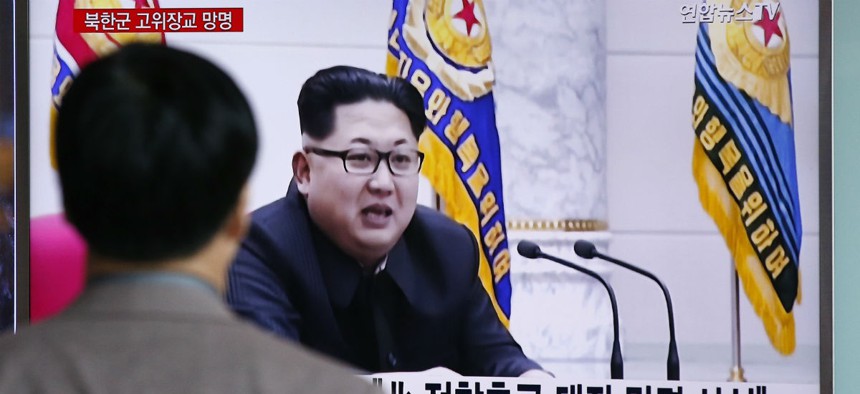Intelligence Chief: We Don't Know If North Korea Has a 'Boosted Bomb'
Pyongyang's bomb-making capabilities remain opaque even to the nation's top spy.
“We don’t really know” if North Korea tested a “boosted” nuclear device this year, the U.S. intelligence chief said Monday.
A boosted nuclear weapon is sometimes described as an intermediary point between a fission bomb and a much more destructive hydrogen bomb.
The seismic data from the Jan. 6 underground bomb test, which produced a 5.1-magnitude quake, indicates that the yield was about 6 kilotons (possibly 10), in line with a conventional fission device, not a thermonuclear bomb, which can have a yield between 15,000 and 50,000 kilotons.
On Monday, Director of National Intelligence James Clapper echoed what most other experts have said: “It was much more modest than they claimed,” he said. “It’s hard to say what they are trying.”
Some have argued that a so-called boosted bomb would represent a significant increase in North Korean capability. In a boosted bomb, fissile material such as plutonium (of which North Korea has a small stockpile) or highly enriched uranium is put into a fissile chain reaction. The reaction fuses deuterium and tritium, two hydrogen isotopes, that have been thrust into the bomb’s core.
“While the fusion reaction does somewhat increase the explosive yield, the main purpose of this reaction is to release lots of neutrons that would then cause many additional fission reactions,” Charles D. Ferguson, the president of the Federation of American Scientists, wrote in January.
Bottom line, it’s not exactly a mega-destructive hydrogen bomb, but it does allow you to get a lot bigger explosion out of much less fissile material. That means you can make smaller bombs that can fly farther atop a given missile.
“A boosted fission bomb alone…would mean that North Korea is well on its way to making nuclear bombs that are small enough and lightweight enough to fit on ballistic missiles,” wrote Ferguson.
That’s far more concerning in the wake of the most recent demonstration of a submarine-launched missile, even though the missile flew only about 19 miles. (A successful test would have flown closer to 200 miles.)
“In the case where North Korea does not need to produce a much bigger explosive yield per bomb, but is content with low to moderate yields, it can make much more efficient use of its available fissile material...and have much lower weight bombs,” Ferguson wrote. He said North Korea probably has enough fissile material to make as many as “a few dozen” bombs. U.S. capabilities for detecting or analysing different tests are limited. Besides seismic tests, the Air Force Technical Applications Center, or AFTAC, at Patrick Air Force Base, Florida, can probe the atmosphere for different isotopes with sensors aboard a Boeing WC-135 Constant Phoenix plane. The presence of tritium would be a more conclusive evidence of a boosted bomb blast. Clapper’s response suggests that AFTAC has yet to detect any telltale tritium.
Other experts were more confident that North Korea had tasted a boosted bomb. "Given Kim Jong-un’s desire to claim North Korea had mastered H-bomb technology, North Korea likely did test a boosted weapon in January," Bruce Bennett, a senior defense analyst with the RAND Corporation, told Defense One. "According to the web site 38 North, the fourth nuclear test was buried about twice as deep as the third nuclear test, suggesting that North Korea was seeking a 50 kiloton or so weapon yield. It got 10 kilotons. From just measuring the weapon yield, we cannot tell whether any of this explosion was due to fusion—the 'h-bomb' component of the explosion. But if North Korea had gotten 50 kilotons, it would almost certainly be the case that fusion was a part of the explosion. I think Kim wanted that proof, and likely was very unhappy that he did not get it," said Bennett.
If North Korea developed a boosted bomb, how soon could they upgrade to a full hydrogen bomb? Clapper would not say.
“Aspirationally, the current regime in North Korea, which is one guy, is very determined to portray to the world that North Korea is a nuclear power and he wants recognition of that,” the U.S. intelligence chief said. “Despite some of the failure that they’ve recently incurred they will continue to press on to develop nuclear capabilities, which I think, ultimately, aspirationally, would include a hydrogen bomb capability. But I certainly can’t prescribe a timeline,” he said. “if you think about it, the North Koreans have achieved an objective there because they’ve created at least the psychology of deterrence.”
"it has taken the big countries 10 years or less to go from first fission test to first significant (beyond boosted) fusion test. On the other hand, the US and Soviet nuclear programs were massively staffed, and the North Korean program is not as well staff or financed," said Bennett.
“I don't know if it is possible within five years,” Ferguson told Defense One in an email. “It seems reasonably clear that they want such a capability. If they had outside help, they might be able to speed up the development process. Even more advanced states such as India and Pakistan have struggled to develop H-bomb capabilities. There are still some who doubt whether those two countries really have such capability. Recall that the United States, Russia, China, France, and the UK made many tests (in the case of the United States more than 1,000) to develop more advanced nuclear weapons. So, North Korea would not be much different,” he said.








